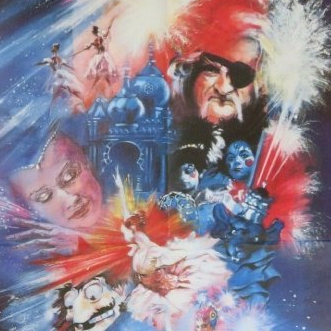Go Down Death
Apparently for a while there in the 2010s, this was basically every director's first film.

Promotional poster | Factory 25
2013 — USA
Cast: DOUG BARRON, BRANDON deSPAIN, RIVIN DISLA, AVI GLICKSTEIN, LUCY KAMINSKY, ERIC MAGNUS, SAMMY MENA, BRYANT PAPPAS, DAVID JOSEPH REGELMANN, JOHN HENRY SOTO, LILIANA VELÁSQUEZ and SIMONE XI
Directed by, Written by, and Music and lyrics by: AARON SCHIMBERG
Producer and Editor: VANESSA McDONNELL
Cinematography: JIMMY LEE PHELAN
Production design: SIA BALABANOVA and KATE RANCE
Costumes: STACEY BERMAN and KARA FEELY
© Post-Original Productions
Aaron Schimberg seems to have largely entered something resembling popular consciousness with 2018’s Chained for Life, except for things like ‘popular consciousness’ as that seems like a colossal overstatement, but vague moderate notice from the critical community sounds pretty lame, so… whatever. His first feature type film however was this, an adaptation of the stories of John Mallory Sinus, one of the great American folklorists. New world folklore’s a weird thing, isn’t it? I don’t mean the indigenous peoples’ folklore, but rather the colonial types who came along and made up their own weird shit, distinct from both the indigenous folklore and that of their European ancestors, even though it was like the Enlightenment and science had been invented, and the United States founding fathers included some key figures of the movement. Then again, I suppose the sort of people who ended up on the frontier probably weren’t the sort of people to be aware of that of stuff. Well, that and Enlightenment era scientific ideas were still a bit weird in places. While the folklores of First Nations peoples and the various Olde World countries are built on centuries or millennia or whatever of history and tradition, these settler folk things seemed to just popup fully formed within the past two or three hundred years. For why these quasi-traditional stories happen, we can only really speculate. Margaret Atwood commented, regarding recurring themes in Canadian writing, that one such pattern “[has] to do with going crazy in the North – or being driven crazy by the North” (Atwood, 77). Of course, Atwood is talking about Canada, which has a whole different set of cultural neuroses to the States, but at the same time it feels plausible that there could be overlap given the notion of ‘the frontier’.
Anyway, the joke here is that John Mallory Sinus is not a real folklorist but rather a product of the filmmakers’ imaginations. For what it’s worth however, he may as well be. Perhaps more than any other settler society, the United States has a sense of self-mythologising, to the point where you have people who only died in the twentieth century, such as Buffalo Bill Cody, that have taken on similar larger than life qualities to figures from antiquity, despite there being actual records from the period, or characters like the Headless Horseman or Rip Van Winkle entering a mythological consciousness despite their origins being very much known. In some ways, it seems appropriate. The movies are in some ways the ultimate expression of American myth making.
A collection of intercut stories set at an unknown time in an unknown place, the action centres around an unnamed village in the woods where it is permanently snowing. This village is at once during the American civil war, frontier times, the old west, the depression, the present day and Armageddon. The denizens of this village whose stories we follow include Butler (Rayvin Disla), a young lad who works multiple jobs to take care of his invalid father and who finds himself being harassed by a sinister doctor (Bryant Pappas) who suddenly replaces the town’s regular one in a blink; Milda (Simone Xi), a tone deaf chanteuse adored by amongst a group of local poker players but who only has eyes for one; Emil (Doug Barron), an old man who engages with his late wife’s identical twin (Lucy Kaminsky); Frederick (David Joseph Regelmann), a self-professed war hero who tries to crack the shell of an anhedonic prostitute (Liliana Velásquez); and Boris and Hugo (Brandon deSpain and Avi Glickstein, respectively), two soldiers on the front waiting for something, anything, to happen, death included.
Got all that? There are actually some more, but I’d probably class those as the main narrative threads that the film keeps coming back to. So technically there’s quite a bit going on for a sub-ninety-minute film. Would you believe there was a fair bit cut out? I mean, you should, obviously; it really does sound like something that would have.
Go Down Death feels like the sort of film I should be all about. It’s got a deadpan sense of absurd humour and an arts ponce nightmare aesthetic. I love those things. And, indeed, it’s difficult to really complain all that much about it. Its main problem is just that it suffers from comparisons to similar works of absurdist nightmare arts ponce comedy, probably most obviously those of Guy Maddin, which do what it does so much better (though to be fair, I've seen films that try and do this kind of shit so much worse too). I’ve seen reviews talk about it in comparison to Maddin’s feature length debut Tales from the Gimli Hospital (as well David Lynch’s Eraserhead (1977)). I haven’t managed to see Gimli Hospital, but I’ve also seen people compare it to some Maddin films that I have seen, both the earlier (relative to this film) My Winnipeg (2007) and his later The Forbidden Room (2015), though frankly it’s lacking those film’s level of conceit and at least the latter’s sense of structure. I suppose to be fair, Go Down Death is more open about the ostensible central conceit of ‘folklore’ than The Forbidden Room is about its ‘lost films’ thing, providing an amusingly daft foreword:
The complete works of folklorist Jonathan Mallory Sinus comprise no more than six pages, including annotations.
Naturally, some extrapolation was necessary to bring this lengthy adaptation to theaters across your country.
—The Producers
Not that it generally feels like it’s doing all that much with that particular premise. It seems like it’s gunning for deeper commentary with things like the townsfolks’ disdain for the city, exemplified in the climax of the film where everything gets all meta and I suppose is a key part of where the comparisons to The Forbidden Room come from. The film starts evoking ideas of a film within a film, eventually making way for the ‘main feature’, featuring a dinner party attended by naval gazing city types with thoroughly petty problems, much to the chagrin of the audience of villagers, except the tales we’ve been watching have also been rendered part of this experience, bleeding as they do into the cinema scenes. These people’s lives are the support feature to that of the city folk.
This perhaps falls somewhat flat, when the whole village, woods and all, is constructed in a warehouse in Brooklyn. This ain’t one of those films actually from the flyover states. The overwhelming falseness of the world the characters inhabit may be a key point however. The village is obviously a construct, but it’s as fictional in its own reality as it is in ours. This weird anachronistic middle America does not, in fact, exist. Or maybe I'm reading into shit that isn't really there. That also seems like a strong possibility.
Still… at least until the denouement (the film grinds to a dead halt in the last ten minutes or so, when we join the dinner party which is interminably boring), the film is reasonably engaging and genuinely pretty funny. The production design and its crisp black and white photography come together to make a fascinating work of art. The elephant in the room is the earlier alluded to cut content however. In fact, the commercial release supplies a whopping thirty minutes worth, including some fairly lengthy scenes that not only expound on character motivations, but that help bridge the disparate scenes in a stream-of-consciousness manner and even ones that act as payoff and punchlines for earlier sequences and character arcs including ones that did make it into the film. These scenes feel like they would have made all the difference between a film that works as a cohesive whole and one that is content to just sort of imitate the nightmare aesthetic and logic of the works of Maddin or David Lynch without really capturing what makes them work. The film looks the part, but ultimately fails to deliver as it just sort of lurches from one handsomely bizarre set piece to another before finally just sort of giving up.
At time of writing, Go Down Death isn't even listed on JustWatch and doesn't appear to be on any major streaming service. Sorry, kids. Alternatively, physical copies are reportedly available for rent via Cinema Paradiso.
The film presently has a 15 rating from the BBFC. It does not appear to have a listing on their website however. So I guess I have to try and do it, but, eh, you know, it's got a little of just about all of the standard criteria; sex, swearing, violence, that kind of stuff. There's even some full frontal nudity for your trouble.
Sources
Atwood, M., 1995. Strange Things. London: Virago. [2004]



